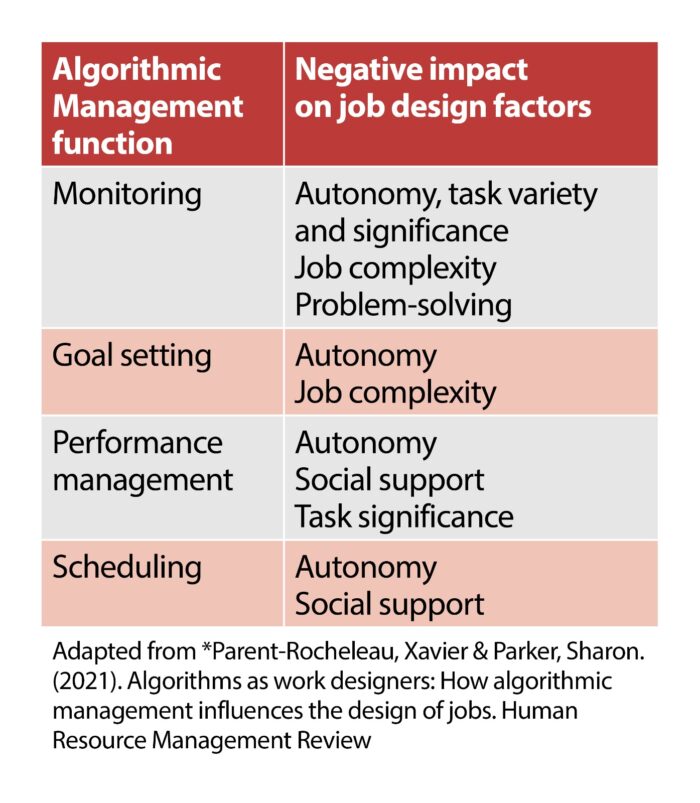How to avoid the negative impacts of algorithmic management
- HRM Asia Newsroom

Businesses have been busy adopting technology powered by artificial intelligence (AI) and delivering them into the hands of employees. Driven by promises of greater efficiency and effectiveness, improving the employee experience, and yielding previously unknown insights through advanced analytics, these tools have improved the quality of decisions and eliminated many of the mundane activities previously performed by people.
There are many advantages offered by AI tools, but there is also a dark side, one which is often overshadowed by the enthusiastic media narrative surrounding AI. HR is familiar with one potential downside, that AI can mirror and magnify biases embedded in our data. Another far less known but potentially more problematic issue is algorithmic management.
Algorithmic management is the use of AI techniques to manage humans in the workplace. Human involvement is limited when AI takes control, making and executing decisions about labour. You may be familiar with the case of Uber drivers in the USA who resisted being “managed by the App” and said they disliked “working for algorithms”. This case highlights an example of algorithmic management, that not only affects platform workers, but many white-collar knowledge workers, whose colleagues and managers are now, in total or in part, a black box. Anywhere AI is the technical part of a sociotechnical system, algorithmic management is likely to exist.

“The need for HR to be involved in conversations across their businesses about the decision to adopt AI is obvious.”- Philippa “Pip” Penfold, Managing Director, Integrating Intelligence.
There has been extensive research since 2015, when the seminal article about the algorithmic management of Uber drivers was published. As a topic, algorithmic management has already generated nearly half as many scientific papers since 2020 as it did in the previous decade.
A recent literature review* suggests that algorithmic management generates more negative outcomes for employees, than positive. A single area seems to produce a positive outcome, the reduction of physical demands. The negative impacts on job design factors of different algorithmic management functions are outlined in the table below.

The list of negative impacts is a cause for concern for any HR professional. Many HR programmes, practices and policies are designed to ensure that people have autonomy in their role, and that there is sufficient task variety and significance, because these are central to employee engagement. The prevalence of autonomy being a negative impact arising from many algorithmic management functions is of particular concern. Autonomy increases employee motivation, engagement, creativity, and contributes to overall job satisfaction.
Could the adoption of AI result in the loss of many of the gains made in employee engagement?
The consequences of AI in the workplace are usually the result of the choices made during the decision to adopt. To avoid or mitigate the negative impacts of algorithmic management, awareness during the procurement stage is the first step. This means ensuring that algorithmic management issues that could arise through the adoption of a specific AI tool, are identified, assessed, and considered during the procurement process. Once the decision to adopt has been made, redesigning jobs astutely, so that both the human and technical aspects of the sociotechnical system are enhanced, can ensure many of the negative effects of algorithmic management are eliminated or reduced.
Jobs that are designed to avoid the negative impacts of algorithmic management allow people to retain control, provide transparency and evoke a sense of fairness. Methods to achieve this could include:
- Ensure people have input into system design and the ability to opt out.
- Only collect reasonable information and ensure decisions are participatory (no unilateral decisions made by technology).
- Decisions made by technology are explainable.
- Human influence is important, give people a way to add their voice to decisions and modify and adapt decisions.
The optimisation of a sociotechnical system that includes AI, through the design of work to ensure people and technology operate effectively together, now also includes design strategies to manage algorithmic management. As artificial intelligence is easy to acquire, the optimal design of a company’s sociotechnical system can be a source of competitive advantage.
The need for HR to be involved in conversations across their businesses about the decision to adopt AI is obvious. Without HR highlighting and assessing the risks inherent to algorithmic management, they are less likely to be known, understood, or addressed sufficiently, resulting in engagement and retention issues in the future that will certainly end up at HR’s feet to solve.
About the Author: Philippa “Pip” Penfold is Managing Director, Integrating Intelligence. Join her at HR Tech Festival Asia 2023 on May 10 at 2pm (SGT), where she will answer questions about HR Jobs of the future.






